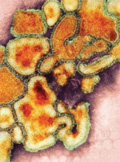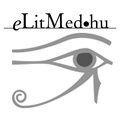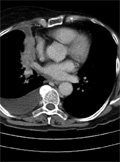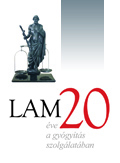The eLitMed.hu medical portal uses computer cookies for convenient operation. Detailed information can be found in the Cookie-policy.
Lege Artis Medicinae - 2011;21(02)
Content
[Influenza vaccination of pregnant women and the experiences related to the pandemic influenza A-virus H1N1 infection in Hungary 2009]
[During the influenza A-H1N1 pandemic, only about 16% of pregnant women were vaccinated against the virus, despite their higher expected mortality risk. According to the official data, five pregnant women died. In addition, the high fever that occurs in influenza increases the risk of some congenital abnormalities. The vaccine used in Hungary is not associated with severe complications in pregnant women and their fetuses, therefore, it can be administered during any stage of pregnancy. The author discusses the causes that deterred pregnant women from being vaccinated. The main problem seems to be that some physicians were under-informed and were reluctant to take responsibility.]
[Current treatment of multiple sclerosis]
[Multiple sclerosis (MS) is an autoimmune and degenerative disorder. In the past decades, the introduction of parenteral immunomodulatory therapies brought significant progress. These agents increase the number of relapses (shubs) by about 30%, and some of them has been shown to halter the accumulation of neurological symptoms and the development of disability. As first-line agents, interferon beta and glatiramer acetate (consisting of amino acids) can be used. Some new therapeutic strategies have been developed as a result of biotechnological development. The advantage of humanised monoclonal antibodies is that they affect the autoimmune inflammatory process more selectively. Among monoclonal antibodies, natalizumab, which binds to alpha-4-beta-1 integrin receptors and inhibits the migration of T-lymphocytes into the central nervous system, is available from February 2010 in Hungary, recommended as second-line treatment. The efficacy of natalizumab in decreasing relapse rate is >60 %. However, its use is associated with progressive multifocal leukoencephalopathy (PML) in one out of 1000 treated patient. Currently it is recommended as second-line treatment, if the patient has active disease despite immunomodulatory therapy. Among orally administered agents, a preparation containing fingolimod is expected to become available next year, and another pill, cladribin has been also found to be efficient in randomised, controlled phase III trials. Fingolimod acts on sphingosine 1-phosphate receptors- 1 (S1P1). Cladribine is a purine nucleotide analogue, and its efficacy is based on long-term reduction of CD4+ and CD8+ lymphocytes. Further promising oral immunomodulatory agents are laquinimod and BG000012 (dimethylfumarate), which are currently being tested in phase III clinical trials in relapsing-remitting MS. The most efficient treatment should be chosed on the basis of the activity, aetiology and the posited pathomechanism of the disease. With the increasing number of therapeutic options, choosing the treatment that is optimal for the patient while also considering side effects might be challenging for both the patients and physicians.]
[Anti-atherosclerotic effect of pioglitazone - The first evidence of the role of triglyceride/HDL ratio]
[The presence of multiple risk factors can multiply exponentially the risk of cardiovascular events, thus cardiovascular diseases are more severe in diabetes mellitus. One of the challenges we face today is the application of drugs that, besides improving glucose homeostasis, also have antiatherosclerotic effect. Such candidates are glitazones, which have pleiotropic efficiency beyond their main effect: they improve distribution of adipose tissue, blood pressure and endothelial function and also have anti-inflammatory and anti-coagulation capacity. Regarding the effects on lipid metabolism, there are differences between various glitazones: improvements are mainly achieved by pioglitazone, which markedly reduces triglyceride levels, and also elevates HDL levels and decreases the ratio of small, dense LDL-particles. Studies on clinical outcomes also show the superiority of pioglitazone. Imaging of blood vessels (carotis-IMT, intracoronary ultrasound technique) also suggest a greater efficiency of pioglitazone. According to the latest analysis of the PERISCOPE study, the stability of the coronary plaque was associated only with the triglyceride/ HDL ratio in case of pioglitazone. The newest data also revealed that pioglitazone uniquely increases the cholesterol-efflux attributed to HDL-related macrophages. On the basis of the latest results, pioglitazone not only improves glucose homeostasis, but also has a remarkable anti-atherosclerotic effect, which is primarily due to its favourable lipid metabolism profile.]
[The significance of generic valsartan in the treatment of patients]
[The renin-angiotensin-aldosterone system (RAAS) is involved in the regulation of electrolyte and water balance primarily; however, it also influences vascular function and increases blood pressure - especially under pathological conditions. Hypertension, post-myocardial infarction state, and heart failure are, for example, associated with excessive systemic and/or local activation of the RAAS. Angiotensin II (AT-II) generated by the latter contributes - along with additional factors and through its deleterious effects (vasoconstriction, endothelial dysfunction, atherosclerosis, prothrombotic state, fibrosis, etc.) - to damage to the target organs involved in the sequence of cardiovascular events. Inhibiting the RAAS at different levels is of therapeutic importance - its purpose is to delay disease progression, to prevent end organ damage, and to achieve a better outcome. As AT-II acts on several (AT1 and AT2) receptors, using angiotensin receptor blocking (ARB) agents with a high selectivity for the AT1 receptor is the rational choice. In view of its favourable therapeutic properties and efficacy demonstrated by morbidity and mortality studies, a generic formulation of appropriate quality, containing valsartan as active substance could prove to be the ideal treatment for patients with hypertension and other cardiovascular disorders.]
[Disabled person’s satisfaction with health and social care - an internationally developed instrument ]
[Introduction - Quality of health and social care is being assessed by largely different methods. Obtaining comparable and valuable data is difficult. Thus, internationally developed instruments have special value. Sample and methods - A set of instruments has been developed simultaneously using World Health Organization’s instrument development method. One of these is the instrument “Quality of Care and Support for People with Disabilities”. Response scales contain five options for physically and three for intellectually disabled persons. Psychometric analysis of the Hungarian instrument version was based on interviews with 151 physically and 166 intellectually disabled persons. Results - Answering rate was high, above 95% with the exception of one item. Internal consistency of the two instrument versions by Cronbach’s alpha is 0.845 and 0.745 respectively. Lowest satisfaction was found in the domain “information” in both groups that correlates significantly with health conditions at p<0.01 and p<0.05 level respectively. Conclusions - The field trial confirms validity and reliability of the instrument. Its wider use may help the evaluation of satisfaction concerning different components of quality of care, consequently better tailoring of services to needs.]
[Myocardial infarction in systemic lupus erythematosus]
[Systemic lupus erythematosus (SLE) is a multisystemic autoimmune disease with relatively common cardiovascular morbidity and mortality. We present a case of a 56-year-old woman treated for SLE, who had an infection of the upper respiratory tract and fever followed by multiple cardiac symptoms: pericarditis, endocarditis and finally acute myocardial infarction (AMI), which was attributed to coronaritis. Acute PCI resulted in revascularisation and combined drug therapy also reduced the patient’s inflammatory symptoms. Our case draws attention to the fact that SLE, as well as diabetes, is a condition equivalent with ischaemic heart disease.]
1.
Clinical Neuroscience
Is there any difference in mortality rates of atrial fibrillation detected before or after ischemic stroke?2.
Clinical Neuroscience
Factors influencing the level of stigma in Parkinson’s disease in western Turkey3.
Clinical Neuroscience
Neuropathic pain and mood disorders in earthquake survivors with peripheral nerve injuries4.
Journal of Nursing Theory and Practice
[Correlations of Sarcopenia, Frailty, Falls and Social Isolation – A Literature Review in the Light of Swedish Statistics]5.
Clinical Neuroscience
[Comparison of pain intensity measurements among patients with low-back pain]1.
Clinical Neuroscience Proceedings
[A Magyar Stroke Társaság XVIII. Kongresszusa és a Magyar Neuroszonológiai Társaság XV. Konferenciája. Absztraktfüzet]2.
3.
Journal of Nursing Theory and Practice
[A selection of the entries submitted to the literary contest "Honorable mission: the joys and challenges of our profession" ]4.
Journal of Nursing Theory and Practice
[End of Life and Palliative Care of Newborns in the Nursing Context]5.
Journal of Nursing Theory and Practice
[Aspects of Occupational Health Nursing for Incurable Patients ]


















